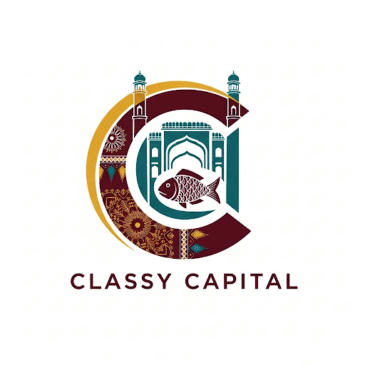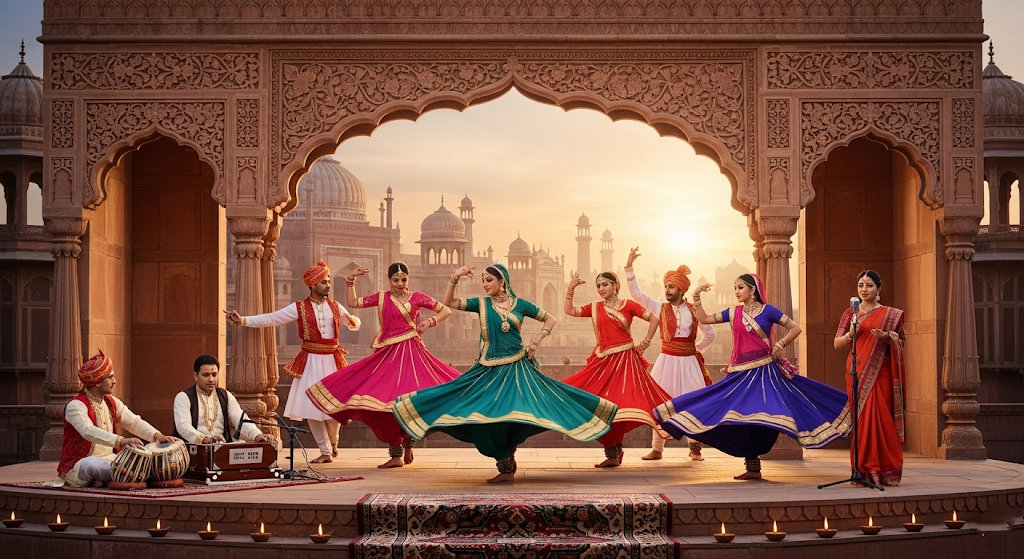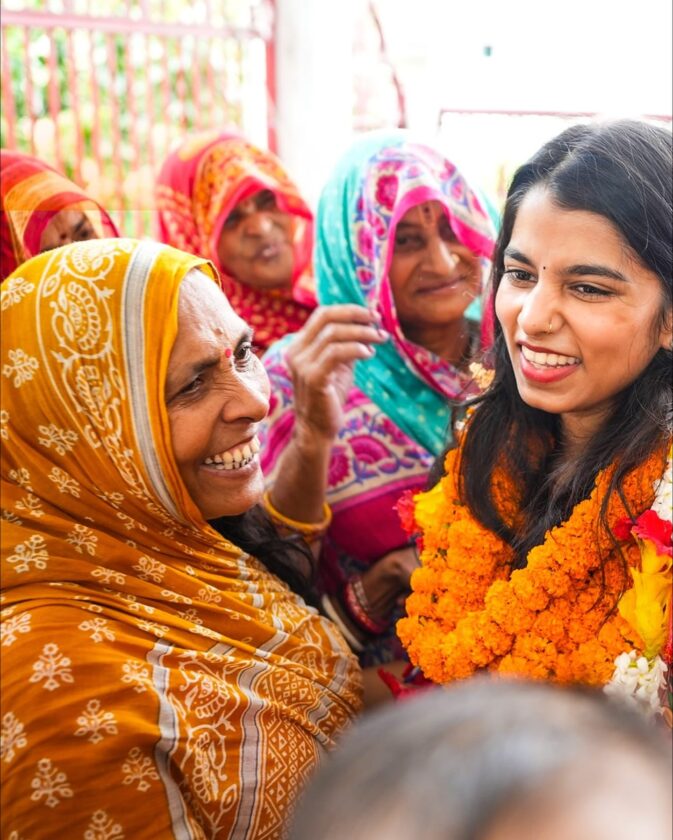 Lucknow: In 1775, when Nawab Asaf-ud-Daula shifted the capital of Awadh from Faizabad to Lucknow, he was not just moving his court—he was setting the stage for one of India’s richest cultural renaissances. Over the next 250 years, Lucknow would blossom into a vibrant hub of music, dance, poetry, and drama, blending Persian refinement, Mughal grandeur, and indigenous traditions into a uniquely syncretic identity known as Ganga-Jamuni Tehzeeb.
Lucknow: In 1775, when Nawab Asaf-ud-Daula shifted the capital of Awadh from Faizabad to Lucknow, he was not just moving his court—he was setting the stage for one of India’s richest cultural renaissances. Over the next 250 years, Lucknow would blossom into a vibrant hub of music, dance, poetry, and drama, blending Persian refinement, Mughal grandeur, and indigenous traditions into a uniquely syncretic identity known as Ganga-Jamuni Tehzeeb.
The city’s courtyards, kothis, and imambaras echoed with kathak footwork, thumri melodies, and poetic recitals. Even as colonial disruption, independence, and globalization transformed India, Lucknow’s performing arts adapted, sustained by passionate masters who ensured that the essence of Awadhi culture never faded.
This is the story of how the performing arts in Awadh—rooted in Nawabi courts—have evolved across epochs, and how modern luminaries have carried them onto global stages.
When Asaf-ud-Daula chose Lucknow as his capital, he invited not only administrators and soldiers but also artists, poets, and musicians fleeing the declining Mughal court in Delhi. Under Nawabi patronage, Lucknow became a crucible of creativity, where music, poetry, and dance thrived as integral parts of courtly life.
Music reached new heights in this period. The Nawabs were connoisseurs, with Wajid Ali Shah (r. 1847–1856) being the most iconic. A poet, composer, and performer, he wrote thumris under the pen name Akhtarpiya. His classic Babul Mora Naihar Chhooto Hi Jaye still resonates as one of India’s most beloved compositions.
Under his influence, the Lucknow Gharana of thumri flourished—lighter and more emotive than the dhrupad and khayal traditions. Simultaneously, the Lucknow Gharana of tabla emerged, shaped by the rhythmic interplay between kathak dancers and pakhavaj percussionists.
Kathak, with roots in temple storytelling, transformed into a refined, expressive court dance under Nawabi patronage. Wajid Ali Shah introduced theatricality through his Raas Leela performances inspired by Krishna, making kathak a blend of devotional, dramatic, and romantic narratives.
The Kalka-Binda lineage, whose descendants include the legendary Achhan Maharaj, Lachhu Maharaj, Shambhu Maharaj, and later Birju Maharaj, gave kathak its Lucknowi identity—marked by delicate abhinaya (expressions), graceful movements, and lyrical footwork.
Lucknow became a literary magnet. Poets like Mir Taqi Mir, Mirza Shauq Asar, Anes, and Dabeer made the city synonymous with Urdu ghazal, marsiya (elegies), and rekhti (poetry in women’s voices). Wajid Ali Shah himself experimented with theatre, writing Ishqnama and staging plays under the pseudonym Qaisar.
Courtesans, or tawaifs, became central cultural figures—accomplished in music, dance, and poetry. Mujras in Lucknow’s kothis blurred the line between entertainment and art, leaving an imprint still felt today.
The British annexation of Awadh in 1856 and the 1857 revolt shattered Nawabi patronage. Wajid Ali Shah was exiled to Calcutta, where he recreated a mini-Lucknow in Metiabruz, keeping thumri and kathak alive in new settings.
Artists back in Lucknow sought patrons among the taluqdars (landed gentry) and urban elites. Yet the performing arts carried social stigma under colonial eyes, often dismissed as decadent.
A turning point came with Vishnu Narayan Bhatkhande, who founded the Marris College of Music in 1926 (later Bhatkhande Music Institute). By codifying Hindustani classical music and offering formal training, Bhatkhande revived thumri, khayal, and kathak, detaching them from courtesan culture and making them respected academic disciplines.
Meanwhile, Urdu poetry blossomed in political resistance. Poets like Josh Malihabadi and Majaz infused Lucknow’s literary scene with fiery nationalism, blending romance with revolution.

With independence came both decline and revival. While kothis faded and traditional patronage waned, institutions and festivals breathed new life into Awadh’s cultural scene.
No figure has been more central to kathak’s modern journey than Pandit Birju Maharaj (1938–2022). Descendant of the Kalka-Binda lineage, he redefined kathak with nuanced abhinaya, complex rhythmic patterns, and universal themes. His choreographies in films like Devdas and Bajirao Mastani brought kathak into popular imagination.

Through workshops abroad and the founding of Kalashram in Delhi, Birju Maharaj trained hundreds, including disciples like Saswati Sen and Shovana Narayan, who themselves carried kathak to global stages. His work ensured that Lucknow’s kathak was not a relic but a living, evolving art.
If Birju Maharaj globalized kathak, Begum Akhtar (1914–1974) immortalized Awadh’s ghazal and thumri traditions. Born in Faizabad, she trained in both Patiala and Lucknow styles. Her renditions of ghazals like Ae Mohabbat Tere Anjaam Pe Rona Aaya remain timeless.
Through concerts, All India Radio, and recordings, she popularized semi-classical music for mass audiences. Her legacy inspired singers like Vidya Rao and Malini Awasthi, the latter blending folk with thumri, echoing Awadh’s inclusivity.
Urdu’s voice in post-independence Lucknow was shaped by poets like Munawwar Rana (1952–2024), whose accessible ghazals on love, family, and social issues won mass appeal. His mushairas carried Lucknow’s poetic legacy into contemporary discourse.
The founding of the Bhartendu Academy of Dramatic Arts (1975) in Lucknow institutionalized theatre, honoring Bhartendu Harishchandra, the father of modern Hindi drama. Directors like Surya Mohan Kulshreshtha revitalized Awadhi theatre, while playwrights such as Amritlal Nagar drew on Nawabi themes to craft modern narratives.
Festivals like the Lucknow Mahotsav (1975 onwards) became annual showcases of kathak, ghazal, qawwali, and theatre, while newer platforms like the Lucknow Literary Festival (since 2013) highlighted both traditional poetry and contemporary writing.
From radio broadcasts of Begum Akhtar to Birju Maharaj’s kathak on YouTube, technology has amplified Awadh’s performing arts beyond borders. Social media allows artists like Malini Awasthi to livestream folk-infused thumri, engaging younger audiences worldwide.
International festivals have invited Lucknow’s kathak and ghazal exponents, leading to collaborations with flamenco, jazz, and ballet, showing that these traditions are both rooted and versatile.
The arts of Awadh are inseparable from its Ganga-Jamuni Tehzeeb. Muharram processions combine marsiya recitations with dramatic storytelling, while Holi and Diwali feature thumri and folk music. Performances transcend religious divides, embodying Awadh’s composite culture.
Even Lucknow’s architecture echoes this. Baradaris, imambaras, and kothis once served as performance spaces, and today they host festivals and concerts that link the past to the present.
Despite this resilience, challenges loom. Younger audiences often prefer pop culture over semi-classical traditions. Commercialization risks diluting kathak and thumri into entertainment stripped of depth. Yet, initiatives like Avadh Sandhya concerts, government support for cultural tourism, and digital platforms offer hope.
Emerging artists, often trained by disciples of Birju Maharaj or inspired by Begum Akhtar, are experimenting with fusion forms that balance authenticity and innovation. As Lucknow grows as a modern metropolis, its arts continue to anchor its identity.
From the Nawabi courts of Asaf-ud-Daula and Wajid Ali Shah to today’s global concert halls and digital platforms, Lucknow’s performing arts have traversed 250 years of transformation. They survived colonial annexation, adapted during independence, and blossomed again in the modern era through the genius of Birju Maharaj, Begum Akhtar, Munawwar Rana, and countless others.
The thumri’s sigh, kathak’s graceful spin, and the ghazal’s poignant couplet are not just artistic expressions—they are echoes of a culture that celebrates inclusivity, resilience, and beauty.
Awadh’s performing arts remain a living testament to its Ganga-Jamuni Tehzeeb: a heritage that has withstood history’s tempests and still whispers, sings, and dances its way into the future.






